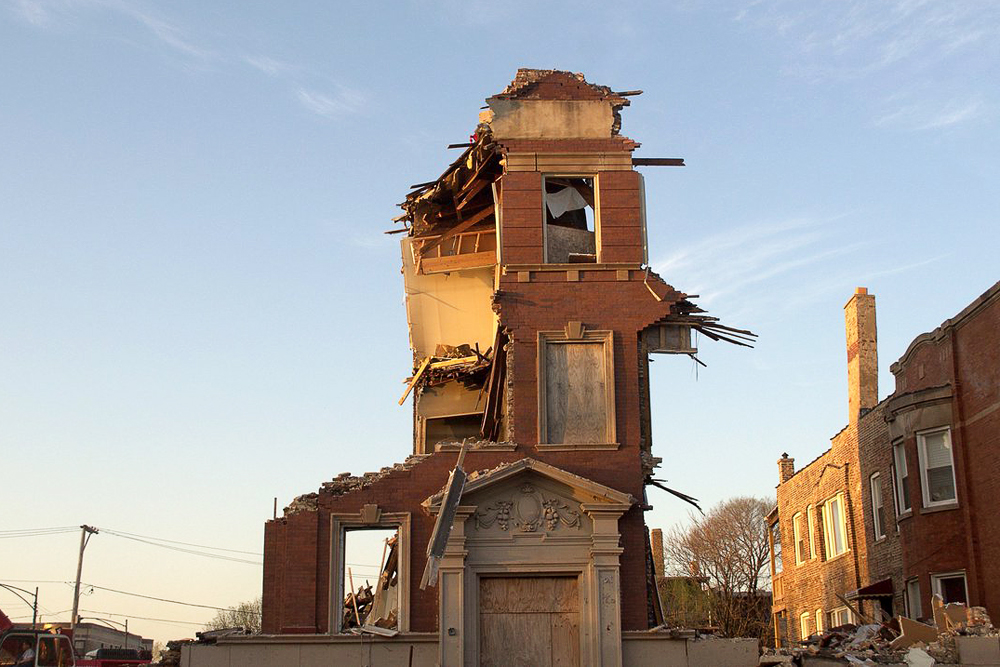Up next in our series of interviews with notable, in-the-know locals: writer Martha Bayne and artist Andrea Jablonski, creators of Theater Oobleck's A Memory Palace of Fear—a haunted house and immersive theater performance running Thursday through Tuesday.
Most people know haunted houses, but this one’s a little different. What should people expect?
Martha Bayne: It starts with a tour in a haunted house environment. First, you meet with a loan officer who will ascertain your fitness for purchasing the home. Then you get a tour of a house that’s for sale. It’s an unusual house, and it’s a little frightening at times, but it’s not your classic zombie-with-a-chainsaw haunted house. We wanted to make it more creepy in atmosphere—not just a series of jump scares. But there are a couple of jump scares.
Andrea Jablonski: I’ve started to describe it like one of those murder mystery parties, where there’s set designs and costumes and someone leads a group through the experience.
M.B.: That’s the first half, which lasts about 20 to 25 minutes. When that’s over you end up in this other space of five art installations, all loosely organized around themes of housing and fear and safety. You can hang out in that room as long as you want. Some people do it in two minutes or some people stay for an hour.
Can you describe some of the installations?
M.B.: There’s one from Gabriel Michael, a photographer who’s been documenting demolished buildings in Chicago. He searches the Department of Buildings for demolition permits, and when he sees a new one, he goes out and takes a picture of the building. So there’s a slideshow of around 200 buildings across Chicago that no longer exist. And then the installation that Andrea and I did drew on these workshops where we had kids draw pictures of things that scared them on fabric, and Andrea turned those into pillows. So there’s a lot of spiders.
A.J.: There’s also a couple guns.
M.B.: That was an intense moment when they started drawing those. I used the conversations I had with them while they were drawing to create a zine—a little booklet. One side is an essay that I wrote about fear, the other is extracts from those interviews. So you can sit there with these pillows and read the zine.
What inspired you to make this type of alternative haunted house?
M.B.: The moment was actually driving home from a meeting with Medill [School of Journalism]’s Social Justice News Nexus—a program that supports reporting on social justice—in the fall of 2015. It was a wet night, it was October, it was spooky, and I was driving past these abandoned buildings on my drive home from Bronzeville to Humboldt Park. I had this idea: those are haunted houses. And since my SJNN fellowship was dealing with housing and segregation and economic inequality, I started thinking about the trope of the haunted house, and all the real-world fears that plague people in their homes. Dirty water and vermin rather than ghosts and zombies. We’re doing this project in a neighborhood with massive amounts of disinvestment, and trying to draw on those themes without trivializing them—to contextualize them in this hokey American folk art form.
A.J.: The goal was really to make an approachable project. People get a haunted house. If we have a theme that draws on how Humboldt Park and its residents have suffered, we can be like, “Hey, these are real challenges. You can have fun while you’re here, but think about it on the way home.”
M.B.: I was also interested in fear in general. How your body responds to fear, how haunted houses stimulate a fear response. Since the election, everyone’s talking about fear. “Don’t run away from the horrors, don’t be afraid.” Maybe a haunted house is a way to create a managed experience of fear, which can then help people cope with everyday fear. I don’t know if it’s true or not, but we’re interested in the thesis.
A Memory Palace of Fear runs Thursday through Saturday from 6 p.m. to 10 p.m., Sunday from 1 p.m. to 5 p.m., and Tuesday from 6 p.m. to 8 p.m. with shows starting every 30 minutes. First two tours of the day are kid-friendly. $10–$20 donation. 4106 W. Chicago Ave.



